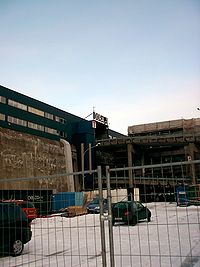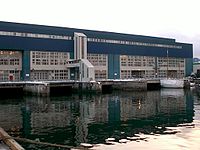
DORA 1
Encyclopedia

Nazi Germany
Nazi Germany , also known as the Third Reich , but officially called German Reich from 1933 to 1943 and Greater German Reich from 26 June 1943 onward, is the name commonly used to refer to the state of Germany from 1933 to 1945, when it was a totalitarian dictatorship ruled by...
submarine base
Submarine base
A submarine base is a military base that shelters submarines and their personnel.Examples of present-day submarine bases include HMNB Clyde, Île Longue , Naval Submarine Base Kings Bay, Naval Submarine Base New London, and Rybachiy Nuclear Submarine Base .The Israeli navy bases its growing submarine...
and bunker built during World War II
World War II
World War II, or the Second World War , was a global conflict lasting from 1939 to 1945, involving most of the world's nations—including all of the great powers—eventually forming two opposing military alliances: the Allies and the Axis...
in Trondheim
Trondheim
Trondheim , historically, Nidaros and Trondhjem, is a city and municipality in Sør-Trøndelag county, Norway. With a population of 173,486, it is the third most populous municipality and city in the country, although the fourth largest metropolitan area. It is the administrative centre of...
, Norway. Trondheim was traditionally referred to as Drontheim in German, and the name DORA is the letter "D" in the German phonetic alphabet
Phonetic alphabet
Phonetic alphabet can mean:* phonetic transcription system: a system for transcribing the precise sounds of human speech into writing.** International Phonetic Alphabet : the most widespread such system...
.
Backgound
Following the occupation of Norway in 1940, it was soon realised that the country only had limited facilites for minor naval repairs. More extensive work usually meant a return to Germany.The capitulation of France two months later overshadowed the strategic importance of Norway to some extent, but it was still regarded as a better location for access to the Atlantic and Arctic Ocean
Arctic Ocean
The Arctic Ocean, located in the Northern Hemisphere and mostly in the Arctic north polar region, is the smallest and shallowest of the world's five major oceanic divisions...
s than Germany. Nevertheless, better protection for U-boats from aerial attack was required so a bunker-building programme was instigated.
Construction
Construction of the bunker which would become part of the largest German naval base in Northern EuropeNorthern Europe
Northern Europe is the northern part or region of Europe. Northern Europe typically refers to the seven countries in the northern part of the European subcontinent which includes Denmark, Estonia, Latvia, Lithuania, Norway, Finland and Sweden...
, started in the autumn of 1941, one year after the invasion of Norway
Operation Weserübung
Operation Weserübung was the code name for Germany's assault on Denmark and Norway during the Second World War and the opening operation of the Norwegian Campaign...
. The concrete roof was 3.5 metre thick and reinforced with steel. The walls were also concrete but these were 3 metre thick. The whole bunker was 153 by 105 m (167.3 by 114.8 yd). The work was undertaken by the Todt Organisation
Organisation Todt
The Todt Organisation, was a Third Reich civil and military engineering group in Germany named after its founder, Fritz Todt, an engineer and senior Nazi figure...
's (OT) Einsatzgruppe 'Wiking' and the Sager & Wörner construction company from Munich
Munich
Munich The city's motto is "" . Before 2006, it was "Weltstadt mit Herz" . Its native name, , is derived from the Old High German Munichen, meaning "by the monks' place". The city's name derives from the monks of the Benedictine order who founded the city; hence the monk depicted on the city's coat...
.
The OT used slave labour extensively; five Serbia
Serbia
Serbia , officially the Republic of Serbia , is a landlocked country located at the crossroads of Central and Southeast Europe, covering the southern part of the Carpathian basin and the central part of the Balkans...
n workers died when a wall fell on them. This incident fuelled a widespread urban legend
Urban legend
An urban legend, urban myth, urban tale, or contemporary legend, is a form of modern folklore consisting of stories that may or may not have been believed by their tellers to be true...
that the Germans simply left the bodies inside the wall. While German engineers did calculate that the five bodies would not weaken the fortification considerably, the bodies were removed before construction continued.
Difficulties with the labour force was not the only problem. The acquisition of raw materials was also a problem. Many Norwegian buildings were erected from timber so cement, sand and aggregate - components essential for the production of concrete - were often hard to extract in sufficient quantities. The steel required for reinforcing was mostly imported from Germany. The weather also played its part; roads and railways were often affected by snow and ice. Pre-fabricated accommodation units from Germany proved to be inadequate. More ships were delayed by the weather than enemy interference. Most construction machinery also had to be imported.
The bunkers in Norway were originally slated for a second floor to be built over the submarine pens. This was to house accommodation, workshops and offices. The idea was abandoned at the end of 1941 due to the problems already mentioned. The choice of site did not help either. Accumulated mud, on top of clay and sand layers proved to be incompatible with existing designs.
Dora 1 devoloped a noticeable sag of up to 15 cm (5.9 in) which seemed to concern the builders more than the U-boat men. It was finally handed over to the Kriegsmarine
Kriegsmarine
The Kriegsmarine was the name of the German Navy during the Nazi regime . It superseded the Kaiserliche Marine of World War I and the post-war Reichsmarine. The Kriegsmarine was one of three official branches of the Wehrmacht, the unified armed forces of Nazi Germany.The Kriegsmarine grew rapidly...
on 20 June 1943 as the home base of the 13th U-boat Flotilla. The bunker, which could be hermetically sealed when attacked, had room for 16 U-boat
U-boat
U-boat is the anglicized version of the German word U-Boot , itself an abbreviation of Unterseeboot , and refers to military submarines operated by Germany, particularly in World War I and World War II...
s and housing for about 200,000 German soldiers.
Construction of a smaller bunker to the west of Dora 1, Dora 2, was started in 1942, but it was only half-completed by the end of the war. This building is presently used by a shipyard
Shipyard
Shipyards and dockyards are places which repair and build ships. These can be yachts, military vessels, cruise liners or other cargo or passenger ships. Dockyards are sometimes more associated with maintenance and basing activities than shipyards, which are sometimes associated more with initial...
.
After World War II

Dynamite
Dynamite is an explosive material based on nitroglycerin, initially using diatomaceous earth , or another absorbent substance such as powdered shells, clay, sawdust, or wood pulp. Dynamites using organic materials such as sawdust are less stable and such use has been generally discontinued...
, but this project was eventually cancelled due to the massive construction and the sheer size of the bunker. Blowing it up would have caused serious damage to the surrounding buildings as well. The base was used briefly by the Norwegian Defence Force
Norwegian Defence Force
The Norwegian Armed Forces numbers about 23,000 personnel, including civilian employees. According to mobilisation plans , the strength during full mobilisation would be approximately 83,000 combatant personnel. Norway has mandatory military service for men and voluntary service for women...
s; two extra stories, painted in blue, were added.
Today, the former naval base is the home of the city and state
State Archive in Trondheim
The Regional State Archives in Trondheim is a regional division of the National Archival Services of Norway and is the national archive for Møre og Romsdal, Sør-Trøndelag, Nord-Trøndelag and Nordland. The State Archives in Trondheim was established in 1850 and is the oldest national archive in...
archives, a bowling alley and several other businesses. The submarine pens originally built for holding German U-boats are now being used as a harbour for civilian boats.
External links
NRKNorsk Rikskringkasting
The Norwegian Broadcasting Corporation , which is usually known as NRK, is the Norwegian government-owned radio and television public broadcasting company, and the largest media organisation in Norway...
, Historien om Dora List of U-boat and torpedo bunkers

